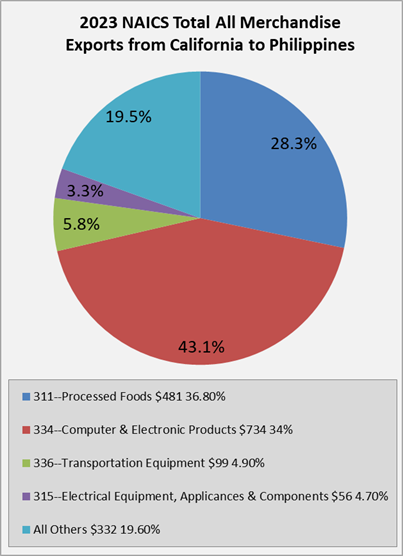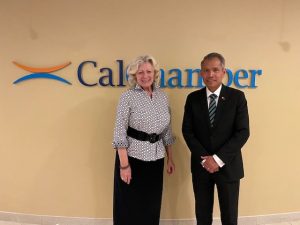Trading Partner Portal: Philippines
Overview
Secretary Raimondo Leads Successful Presidential Trade and Investment Mission to the Philippines, President’s Export Council Trip to Thailand
U.S. Department of Commerce, March 19, 2024
Trade Overview
 The Philippines is a country in Southeast Asia in the Western Pacific comprised of more than 7,000 islands. The population is 115.8 million as of 2024, making it the 14th largest country in the world. It also has one of the youngest populations in the world, with more than two-thirds of the population under the age of 35. The Philippines has a nominal GDP of $470 billion and GDP per capita of $4,154. Until 2020, the Philippines had a year-on-year growth that was one of the fastest in the region, growing 6.12% in 2019. Export.gov
The Philippines is a country in Southeast Asia in the Western Pacific comprised of more than 7,000 islands. The population is 115.8 million as of 2024, making it the 14th largest country in the world. It also has one of the youngest populations in the world, with more than two-thirds of the population under the age of 35. The Philippines has a nominal GDP of $470 billion and GDP per capita of $4,154. Until 2020, the Philippines had a year-on-year growth that was one of the fastest in the region, growing 6.12% in 2019. Export.gov
U.S. – Philippines Trade
In 2024, two-way trade between the U.S. and Philippines equaled $23.48 billion. The U.S. exported $9.3 billion to the Philippines with computer and electronic products making up $2.80 billion of the total, followed by processed foods ($2.35 billion), agricultural products ($896 million), chemicals ($678 million), and electrical equipment, appliances & components ($542 million). The Philippines is the 37th largest export partner for the U.S.
The U.S. imported $14.18 billion worth of goods from the Philippines in the same year. This total was comprised of computer and electronic products ($6.29 billion), followed by electrical equipment, appliances, & components ($1.76 billion), processed foods ($1.35 billion), transportation equipment ($1.02 billion), and non-electrical machinery ($712 million). The Philippines is ranked 31st in import markets for the U.S.
California-Philippines Trade

In 2024, California exported $1.35 billion to the Philippines, making it California’s 27th largest export partner. California’s main export to the Philippines is processed foods making up $479 million of the total, followed by computer and electronic products ($444 million), chemicals ($87 million), transportation equipment ($76 million), and non-electrical machinery ($72 million).
Imports from the Philippines totaled $5.17 billion, ranking 17th in import markets for the state. California’s top imports were computer and electronic products which made up $3.33 billion of the total. This was followed by processed foods ($452 million), electrical equipment appliances & components ($376 million), transportation equipment ($228 million), and plastic and rubber products ($160 million).
FDI – Philippines
Net foreign direct investment (FDI) inflows have been on an upward trend since the administration of former President Benigno Aquino III and rose by more than 40 percent year-on-year during 2016 to a record-high $7.9 billion (from $1.1 billion in net FDI flows in 2010 when the former President assumed office). The United States — with an estimated $6.1 billion of FDI in the Philippines as of 2024- ranks among the Philippines’ top investors. The Philippines invested $532 million into the U.S. in 2024.
Per the most recent census, there are approximately 4 million Philippine-Americans living in the U.S. with half or about 2 million living in California – many who are American citizens or dual-citizens.
More Articles:
1989 bilateral Trade and Investment Framework Agreement (TIFA)
United States Trade Representative – Philippines
Presidential Trade and Investment Mission: Partnering with the U.S. Private Sector to Deepen U.S.-Philippine Commercial Ties
U.S. Department of Commerce, March 12, 2024
Trade Agreements & Issues
Issues
The Philippines has improved in various competitiveness rankings. However, the inadequate state of infrastructure remains a weak spot, and investors also continue to cite government red tape, regulatory uncertainties, a slow judicial system, and corruption as challenges to doing business in the country. Export.gov
Trade Agreements
How About a U.S.-Philippine Free Trade Agreement, U.S. Chamber of Commerce, January 8, 2018
One tangible outcome of President Trump’s recent visit to Manila was an agreement that the two countries would hold exploratory talks on a bilateral free trade agreement. As the joint statement between Trump and Philippine President Duterte said, “The United States welcomed the Philippines’ interest in a bilateral free trade agreement and both sides agreed to discuss the matter further through the United States– Philippines TIFA [Trade and Investment Framework Agreement].”
Regional Comprehensive Economic Partnership (RCEP)
After 8 years of negotiations, the Regional Comprehensive Economic Partnership (RCEP) was signed on November 15, 2020. The RCEP is a free trade agreement (FTA) with 10 Association of Southeast Asian Nations (ASEAN) member states—Brunei, Burma (Myanmar), Cambodia, Indonesia, Laos, Malaysia, the Philippines, Singapore, Thailand, Vietnam—and the five states with which ASEAN has existing FTAs—Australia, China, Japan, South Korea and New Zealand.
Please see the CalChamber’s RCEP pagefor more info.
RCEP – Association of Southeast Asian Nations
Text of the Regional Comprehensive Economic Partnership Agreement
Events
Events
